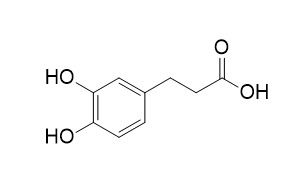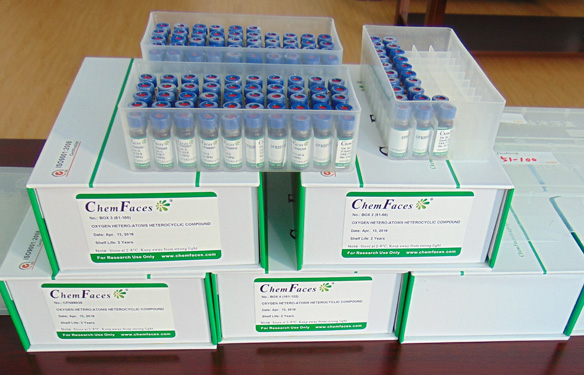3,4-Dihydroxyhydrocinnamic acid
3,4-Dihydroxyhydrocinnamic acid shows antioxidant, and anti-inflammatory properties. It can inhibit the activity of tyrosinase for the oxidation of DOPA.
Inquire / Order:
manager@chemfaces.com
Technical Inquiries:
service@chemfaces.com
Tel:
+86-27-84237783
Fax:
+86-27-84254680
Address:
1 Building, No. 83, CheCheng Rd., Wuhan Economic and Technological Development Zone, Wuhan, Hubei 430056, PRC
Providing storage is as stated on the product vial and the vial is kept tightly sealed, the product can be stored for up to
24 months(2-8C).
Wherever possible, you should prepare and use solutions on the same day. However, if you need to make up stock solutions in advance, we recommend that you store the solution as aliquots in tightly sealed vials at -20C. Generally, these will be useable for up to two weeks. Before use, and prior to opening the vial we recommend that you allow your product to equilibrate to room temperature for at least 1 hour.
Need more advice on solubility, usage and handling? Please email to: service@chemfaces.com
The packaging of the product may have turned upside down during transportation, resulting in the natural compounds adhering to the neck or cap of the vial. take the vial out of its packaging and gently shake to let the compounds fall to the bottom of the vial. for liquid products, centrifuge at 200-500 RPM to gather the liquid at the bottom of the vial. try to avoid loss or contamination during handling.
Phytother Res.2019, 33(3):676-689
Chinese J of Tissue Engineering Res.2022, 26(17): 2636-2641.
Comput Biol Med.2024, 178:108775.
Kor. J. Herbol.2022, 37(5): 89-96.
J Physiol Biochem.2024, 80(2):421-437.
Phytomedicine.2021, 84:153501.
Anal Bioanal Chem. 2025, 417(17):3879-3892.
Phytochemistry.2024, 222:114102.
African J. Agricultural Research 2017, 12(13):1164-1168
Nutrients.2019, 11(4):E936
Related and Featured Products
Journal of agricultural and food chemistry, 2017.
Identification and Quantification of Potential Anti-inflammatory Hydroxycinnamic Acid Amides from Wolfberry.[Reference:
WebLink]
Wolfberry or Goji berry, the fruit of Lycium barbarum, exhibits health-promoting properties that leads to an extensive study of their active components.
METHODS AND RESULTS:
We synthesized a set of hydroxycinnamic acid amide (HCCA) compounds, including trans-caffeic acid, trans-ferulic acid, and 3,4-Dihydroxyhydrocinnamic acid, with extended phenolic amine components as standards to identify and quantify the corresponding compounds from wolfberry and to investigate anti-inflammatory properties of these compounds using in vitro model. With optimized LC-MS/MS and NMR analysis, nine amide compounds were identified from the fruits. Seven of these compounds were identified in this plant for the first time. The amide compounds with a tyramine moiety were the most abundant.
CONCLUSIONS:
In vitro studies indicated that five HCCA compounds showed inhibitory effect on NO production inuded by lipopolysaccharides with IC50 less than 15.08 μM (trans-N-feruloyl dopamine). These findings suggested that wolfberries demonstrated anti-inflammatory properties.
J.agric.food.chem, 1998, 45(12):1203–1208.
Isolation of C-glucosylflavone from lemon peel and antioxidative activity of flavonoid compounds in lemon fruit.[Reference:
WebLink]
METHODS AND RESULTS:
Two antioxidative two C-glucosylflavones were isolated from the peel of lemon fruit (Citrus limon B(URM). f.). They were identified as 6,8-di-C-beta-glucosyldiosmin (LE-B) and 6-C-beta-glucosyldiosmin (LE-C) by UV, IR, FAB-MS, 1H NMR, and 13C NMR analyses. The antioxidative activities of LE-B, LE-C, and flavonoid compounds (eriocitrin, diosmin, hesperidin, and narirutin) in lemon fruit were examined using linoleic acid autoxidation, the liposome oxidation system, and the low-density lipoprotein (LDL) oxidation system. LE-B and LE-C showed antioxidative activity in these autoxidation systems but exhibited weaker activity than eriocitrin, its eriodictyol of its aglycon.
Eriocitrin and its metabolites by intestinal bacteria (eriodictyol, 3,4-Dihydroxyhydrocinnamic acid, and phloroglucinol) exhibited stronger antioxidative activity than alpha-tocopherol in the LDL oxidation system and had approximately the same activity as (-)-epigallocatechin gallate.
CONCLUSIONS:
Eriocitrin and its metabolites are powerful antioxidants using an in vitro oxidation model for heart disease.
Food Chemistry, 2007, 103(4):1075-1079.
Inhibitory effects of substrate analogues on enzyme activity and substrate specificities of mushroom tyrosinase.[Reference:
WebLink]
Tyrosinase can catalyze the oxidation of o-diphenols to o-quinones.
METHODS AND RESULTS:
In this paper, some o-diphenols were used as mushroom tyrosinase substrates to study the catalyzed specificity of the enzyme. The enzyme kinetic analysis of substrate specificities and the substrate analogues towards mushroom tyrosinase has been investigated. Taking l-3,4-dihydroxyphenylalanine (I), 3,4-Dihydroxyhydrocinnamic acid (II), 3,4-dihydroxycinnamic acid (III) and 1,2,4-benzenetriol (IV) as substrates, the results of specificity studies showed that the oxidation reaction of tested o-diphenols by mushroom tyrosinase followed Michaelis–Menten kinetics. The Michaelis–Menten constants for these four substrates were determined to be 0.615, 1.238, 0.331 and 1.886 mM, respectively. The values of Vm/Km, which denotes the affinity of the enzyme to the substrate, were determined and compared, and the results showed that the affinity of the enzyme to these substrates followed the order: compound IV > III > I > II. Furthermore, mushroom tyrosinase cannot catalyze the oxidation of 3,4-dihydroxybenzonitrile (a), 3,4-dihydroxybenzaldehyde (b), 3,4-dihydroxybenzoic acid (c) and 2,3-dihydroxybenzoic acid (d). On the contrary, compounds a, b and c can inhibit the activity of tyrosinase for the oxidation of DOPA, while compound d had no effects on enzyme activity.
CONCLUSIONS:
The results show that compounds a and b are reversible non-competitive inhibitors.



